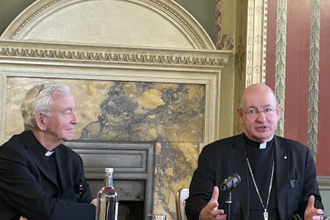A Monastic Garden in Venice

The monastic garden at San Giorgio Maggiore, showing Longstaffe Gowan's revival of the use of straw between beds of flowers and vegetables
In her account of her travels in Italy in 1784, the Anglo-Welsh traveller Hester Piozzi describes a visit to the Benedictine monastery of San Giorgio Maggiore, in order to see a famous painting there: Paolo Veronese's Marriage at Cana (now in the Louvre). Sadly, she recounts: 'When we arrived, the picture was kept in a refectory belonging to friars… and no woman could be admitted.' Her 'few entreaties for admission' are 'completely disregarded by the good old monk, who remained outside with me, while the gentlemen visited the convent without molestation.' Things soon get even worse: 'At my return to Venice I met little comfort, as everybody told me it was my own fault, for I might put on men's clothes and see it whenever I pleased, as nobody then would stop, though perhaps all of them would know me.'
In contrast to Piozzi's melancholy experience, the monastery has recently been opening up to visitors parts of the grounds that have previously been off limits. The Abbazia di San Giorgio Maggiore - Benedicti Claustra Onlus - has collaborated with the Caravane Earth Foundation to host a project that forms part of the Venice Architecture Biennale (more technically, the Seventeenth International Architectural Exhibition), which began on 22 May and ends on 21 November. Caravane Earth - a group concerned with architecture and sustainable living - approached the British landscape architect Todd Longstaffe-Gowan to design a garden for the biennale in which to set a 'majlis', or large elliptical bamboo tent. It was agreed that the monastery of San Giorgio was an ideal site: not only is there a spacious garden there, but it is architecturally distinguished - the church was designed by Andrea Palladio - and is sited on an island easily reached by vaporetto. Happily, the monks were receptive to the idea.
The monastery - established in 982 AD - is known to have had extensive gardens, which were documented in topographical views during the sixteenth and seventeenth centuries. In designing the new garden there, Longstaffe-Gowan sought to evoke (rather than simply to recreate) an early monastic garden; he drew on the traditions of horticulture in the Veneto, strongly aware of the role of Venice as the centre of the European trade in spices and exotic plants. The garden contains not only flowers but also a range of vegetables and medicinal, culinary and aromatic herbs that are specific to the region, as well as non-native species introduced during the Middle Ages and the Renaissance; the plants selected include Cuban oregano (Plectranthus amboinicus), Erba di San Pietro (Tanacetum balsamita), and a range of Venetian artichokes and summer cabbages. The final choice was guided by Isabella dalla Ragione, a specialist well known in Italy for her work to preserve biodiversity and safeguard traditional knowledge, rural culture and oral history. A visually striking element is Longstaffe-Gowan's use of the local custom of strewing straw in deep trenches between raised beds - long used as a means of suppressing weeds and retaining moisture.
Ironically, given this close concern with the history of the Veneto, the garden is more exuberant than is now usual in Venice, where the choice of plants is usually limited and the layout lacking in variety. Its imaginative and inventive qualities have excited some interest and comment among Venetians.
British landscape gardeners are used to designing instant gardens for events such as the Chelsea Flower Show. This monastic plot is rather different: it was conceived as a living, working garden, and there a possibility that it will continue to be enjoyed and cared for beyond the time of the Biennale. Longstaffe-Gowan regularly discussed his aesthetic and horticultural strategies with the monks, in informal chats over the meals that they invited him to share with them, and they are mulling over the idea of continuing to tend it as a permanent space - for their own enjoyment, and possibly for that of visitors. He boldly expresses the hope that their talent for lively commensality and gastronomic finesse might bolster their delight in growing plants long savoured by local gardeners and gourmets, within a space of contemplation and reflection.
Chloe Chard's most recent book is Tristes Plaisirs: A Critical Reader of the Romantic Grand Tour (2014), published by Manchester University Press. She has also written Pleasure and Guilt on the Grand Tour - Manchester University Press (1999)
Todd Longstaffe-Gowan's English Garden Eccentrics: Three Hundred Years of Extraordinary Groves, Burrowings, Mountains and Menageries will be published in April 2022 by the Paul Mellon Centre for Studies in British Art.
LINK
San Giorgio Maggiore - https://buffaloah.com/a/virtual/italy/venice/giorgio/int.html


















